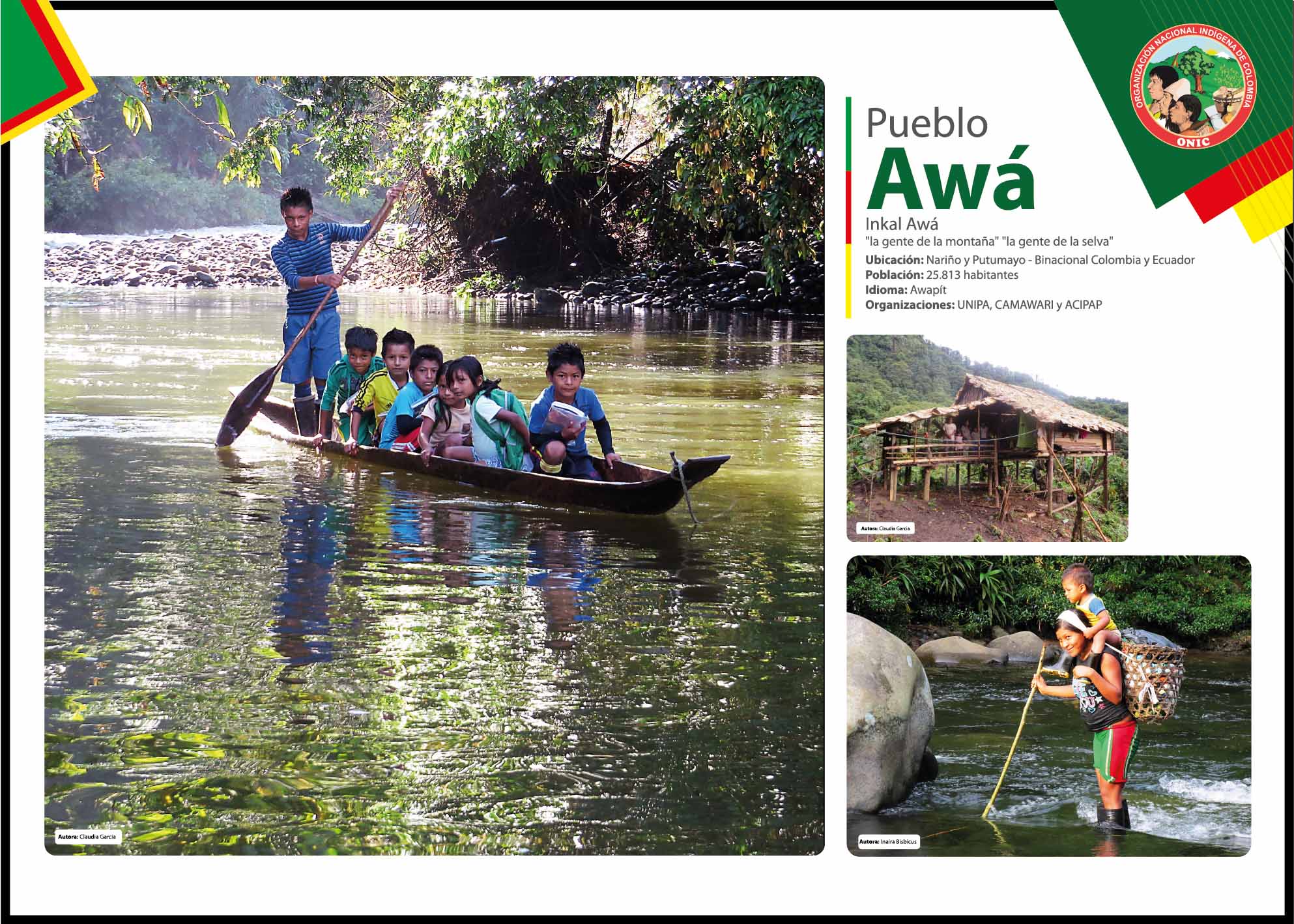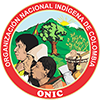Awá

OTHER NAMES:
Awá "the people of the mountain" "the people of the jungle" - Awá, cuaiquer, kwaiker
GEOGRAPHICAL LOCATION:
The Awá have a binational presence; They are found in Colombia and Ecuador. In Colombia they are located in the southwest in the municipalities of Cumbal, Santa Cruz de Guachavez, Mallama, Ricaurte, Barbacoas, Roberto Payán, Tumaco and Ipiales, in the department of Nariño, and in the municipalities of Mocoa, Puerto Asís, Valle del Guamuez, San Miguel, La Dorada, Orito, Puerto Caicedo, Villa Garzón in the department of Putumayo.
LANGUAGE:
From the Awapit language, which belongs to the Chibcha language family. It is part of the Sindaguas Malla dialect; related to the Chá palaa (language of the Chachi Nationality) and with the Tsa'fíqui (language of the Tsa'chila Nationality).
POPULATION:
With an approximate area of 3000 square Kilometers, the ethnic group is characterized by dispersed settlements that follow the current of the rivers. Its population is estimated at 25,813 people (DANE. 2005. National Population Census)
The climatic conditions make that the highest population concentrations are located in the altitudinal part of the 500 to 1,500 meters above sea level, since the indigenous people seek the low terraces to cultivate and build their homes, while the upper part of the massif is an area reserved for hunting.
CULTURE AND HISTORY:
The origin of the ethnic group is uncertain and confusing, since archaeological studies show that the coast, both Colombian and Ecuadorian, was inhabited by the Tumaco culture. Upon the arrival of the Spaniards in 1525, the chronicles give account of semi-nomadic indigenous groups with a very low degree of development in relation to the other ethnicities found in the Andean region.
During the colony, the groups in the region, generically referred to as "Barbecues", were grouped into "Indian villages", according to the Hispanic population model. The colonizing pressure of the region increased significantly as this area became one of the main gold fields and port centers - in the case of Barbacoas - a situation that forced the indigenous people to move outside their traditional territory.
Its location in one of the communication axis between the coast and the Andean plateau, has significantly influenced the conformation of its territory, which has been affected by mining booms, civil wars, livestock colonization processes, timber and of illicit crops, in addition to large infrastructure works such as the road to the sea. From the sixties, when the arrival of settlers, miners and palm oil extractors intensified, many indigenous people had to restart the migratory processes.
The highest indigenous concentration is found in the municipality of Ricaurte, due in part to the climatic conditions that allow greater agricultural activity. These same factors have favored the colonization of these lands and other areas to the detriment of indigenous settlements, mainly in areas near the road and marketing centers, such as Talambí, Numbí, Puente Piedra, Pialapí, San Pablo, Cuayquer Viejo, Vegas and El Diviso.
About the AWÁ culture : The cultural dynamics in the Awá people are primarily promoted by the elders (men and women) in their capacity as custodians of the inherited traditional knowledge and in turn the bridges for the spiritual connection of the community. Their role is fulfilled in the form of wise men, traditional doctors and spiritual guides.
The Awa have a great influence of the peasant peoples that inhabit the region, which especially affects the new generations. Traditional aspects, such as dress, have been disappearing with the passing of time. In most settlements practices such as basketry are preserved, whose elaboration is still at hand. In the poorest and most remote regions, utensils are still made of clay and wood, but it is very common that they no longer use objects of an ancestral nature, since they have been replaced by western objects such as lighters, plastic vessels, thermos, mills, etc. Within its worldview the world is populated with supernatural beings. Magic plays an important role as does the practice of Catholic rituals.
ECONOMY AND HOUSING :
Although hunting was their traditional subsistence activity, the unfavorable conditions of their environment have forced them to develop other economic activities such as agriculture, fishing and raising domestic animals. Its agricultural system focuses on the "felling and rotting" technique. The main product is corn, which is combined with the sowing of cassava, beans, sugar cane and plantain. In lands not suitable for agriculture, edible products, medicinal plants and construction timber are collected. The extraction of gold from alluvium occupies a complementary line within its economy.
THEIR HOUSING :
Awa housing follows the construction line that characterizes the Pacific region, that is, aerial housing. Its structure consists of one bedroom, one kitchen and a very wide corridor. They are houses made of chonta and gualte palm leaf, which are crushed to form a mat. The floor is made of wood and the roof has a wide slope to evacuate the water when it rains. Domestic animals are collected in the space under the house.
Their residence pattern is characterized by the dispersion of their settlements along the rivers. They live in houses separated from each other, for several hours on the way. The settlements have a nucleus of houses belonging to people with direct ties of consanguinity, who in turn exercise management functions of the settlement.
Sources:
Arango y Sánchez. Los pueblos indígenas de Colombia 1997.
Dane: Censo1993 -Proyección 2001-.
Martínez, Edgar et. al. Comunidad Cuayquer, Diagnóstico Preliminar, Pasto, Colombia, 1984.
Perafán, Carlos C., Azcárate Luis José. Sistemas Jurídicos Cocama y Awa, Ican, Santa Fe de Bogotá,1997.
Osborn, Anne. Estudios sobre los indígenas Kwaiquer de Nariño, Colcultura, Ican e Icbf, Santa Fe de Bogotá,1991.
Fundación Hemera – Etnias de Colombia.
Los Pueblos Indígenas de Colombia en el umbral del Nuevo milenio – DNP – Departamento Nacional de Planeación.
-Recuperado de: TodaColombiaPuebloAWA
-República de Colombia: Colombia. Ministerio del Interior. Awa Kuaiker.
Artículos Relacionados:




